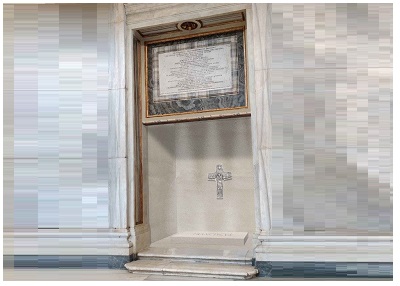Pope’s tomb made of slate from the land of his Italian grandparents
VATICAN CITY – The Pope’s tomb, in the Basilica of Santa Maria Maggiore, will be made with material of Ligurian origin, it will have only the inscription “Franciscus” and the reproduction of his pectoral cross: it will be in the niche of the side nave between the Pauline Chapel (Chapel of the Salus Populi Romani) and the Sforza Chapel of the Liberian basilica, located near the Altar of Saint Francis. And it will be on the ground, as the humble Francis wanted and asked it to be.
The detail of the provenance of the stone had already been anticipated by Cardinal Rolandas Makrickas, coadjutor archpriest of Santa Maria Maggiore, in a TV interview: Pope Francis – alias Jorge Mario Bergoglio, Argentine with Italian origins – expressed his desire to be buried in a tomb made with “stone from Liguria, which is the land of his grandparents” (maternal, ed).
Well, that stone is the slate of Lavagna, “black – writes Vatican News in the article La tomba del Papa sarà in marmo di provenienza ligure, terra dei suoi nonni – like the ink of memories”, and “it comes from the quarries that overlook the Gulf of Tigullio, in the eastern Liguria (Italy), between Sestri Levante and the Val Fontanabuona. Hard, leathery, but capable of melting under the expert hands of those who extract it, the Italian ‘spacchini’. Just like the soul of the Ligurians: sharp on the outside, but inclined to give in to emotion”.
And it was precisely to the emotion, the most intense one, the one of the roots, that the Pontiff must have given in when he made the decision to want that stone for his tomb. A sort of “homecoming” for him, son of emigrants coming from the very lands where that stone is extracted (read our previous article here: Francis, a Pope son of emigrants: “He has always been proud of his Italian origins”). As Vatican News writes, “there is a strange, profound correspondence between slate and the soul of Pope Francis. Just listen to its history, observe its material, follow its tracks. And suddenly, the analogies become clear…”.
These tracks are traced by Franca Garbarino, president of that Slate District, which includes eighteen quarries and twelve companies scattered across the Ligurian hills and is ready to provide all the stone needed to complete the work. “It is not a noble stone – she says – , it has always been the stone of the people”. Humble, resistant, essential. Just like him, the Pope, always close to the least. A material that does not impose itself, but accompanies. It paved the paths. “It is a warm stone”, adds Franca Garbarino. “If you touch marble, you feel the cold. Slate, on the other hand, gives off heat”. Warmth, writes Vatican News, “like a caress, like a presence that consoles. The Pope of tenderness, who was not afraid to bend down. And then there is the color. Black, deep. But never dark…”.
“It goes with any other material” Garbarino emphasizes. Slate does not exclude, it adapts. Like the late Pontiff, capable of speaking with everyone, of dialoguing with believers and non-believers, with distant cultures. The perfect stone for his eternal rest.
In the image above, a rendering of Pope Francis’ tomb



